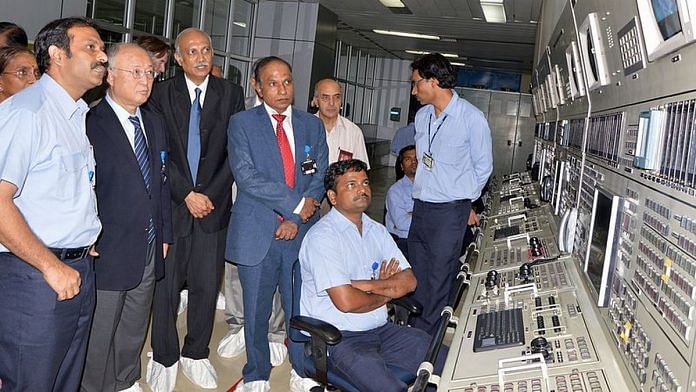New Delhi: Monday marks the 50th anniversary of the Tarapur Atomic Power Station or TAPS as it is known. Located in the industrial area of Boisar in Maharashtra’s Thane district, TAPS was India’s first atomic power project when it began operations on 28 October, 1969.
Launched under the Lal Bahadur Shastri government, TAPS relies on boiling water reactors (BWRs) for power generation. BWRs are nuclear reactors using water as a coolant and moderator, with steam being produced in the reactor that is then enriched with uranium oxide.
The BWRs actually boil water, which is then converted to steam and recycled back to water through a condenser to be re-used in the heat-generation process.
The first of these reactors for Tarapur was acquired by Homi Bhabha, considered the father of India’s nuclear programme. It was regarded as a pioneering move for two reasons. First, because the technology was new, and second, because it showed Bhabha’s confidence in international cooperation as the project was completed with US collaboration.
Also read: For 31 years after his death, Homi Bhabha’s office room was unoccupied
An American collaboration
The nuclear plant is the result of New Delhi’s collaboration with the US. The contract for the plant was signed between the two countries in May 1964.
The BWRs were supplied by the US conglomerate General Electric (GE); over 100 Americans were part of the project. Five years after the contract was signed, commercial operations began in October 1969.
While the contract stated that the US would supply enriched uranium for 30 years, this was cut short in 1974 after India conducted its first successful nuclear test in Pokhran under Operation Smiling Buddha.
Pokhran-I marked the first confirmed nuclear weapons test by a nation outside the five permanent members of the United Nations Security Council. This angered the US as it was trying to expand the ambit of the Nuclear Non-Proliferation Treaty (NPT) and thus in retaliation, Washington cut off uranium supply after 1974.
After the US stopped supplying uranium, however, countries such as China, France and Russia stepped up with the nuclear fuel.
At present, the Tarapur Atomic Power Station is operated by the Nuclear Power Corporation of India Limited (NPCIL).
Also read: Nuclear war is still very possible and very scary
Second most powerful reactor in India
In 2014, Tarapur Atomic Power Station accounted for almost 28 per cent of India’s total nuclear energy production as of 31 March that year, according to NPCIL.
While the two BWRs of 160 MW capacity were commissioned at Tarapur in 1969, the two Pressurised Heavy Water Reactors (PHWR) of 540 MW were added on 12 September 2005 and 18 August, 2006. The four reactors combined have a power generation capacity of 1,400 MW.
That makes the Tarapur reactor the second most powerful in India after the Kudankulam Nuclear Power Plant in Tamil Nadu, which has a power generation capacity of 2,000 MW.
Fears from Fukushima
Following the Fukushima nuclear accident in 2011 in Japan, where a tsunami disabled the power supply and cooling of three Fukushima Daiichi reactors, fears have been raised about the Tarapur plant.
The Fukushima plant also relied on BWRs for power generation. Local residents in Tarapur have been calling for the plant to be shut down.
Jitendra Raul, leader of the Tarapur Progress Community, said at the time, “I think it should be shut down. Should we wait till the time there is some big incident or some big blast inside the power plant?”
Also read: All about the 2 deadly Air India crashes in France whose victims Modi will honour today




Shri. Sundar is right. Showing a wrong picture itself shows it is not a direct reporting. TAPS 1, 2 have been managed with all design improvements based on events in nuclear power plants. In India we do not just go ahead with NPP design and operation. Regulatory mechanism is robust and may be cause of delays in construction of NPPs. The article is one more on Nuclear Power in India, without understanding what is really going on. Print has the reputation of publishing such articles.
The Main Control Room shown belongs to the PHWR Reactor at Tarapur facility.
Periodic Safety Reviews undertaken by AERB, DAE after TMI, Chernobyl and Fukushima Daichi . Various upgrades retrofitted wrt emergency power supply, filtered containment venting system, RPV in service inspection etc. it’s not the fifty year old design which is being operated. Also Design Basis Safety Review has been conducted systematically. Ageing Management including degradation mechanism and methodology for identification for Systems, Structures and Components SSC has been carried out.
Indian Atomic Energy regulator approves Plant Operations at every five years intervals.
Article doesn’t reflect entire process.